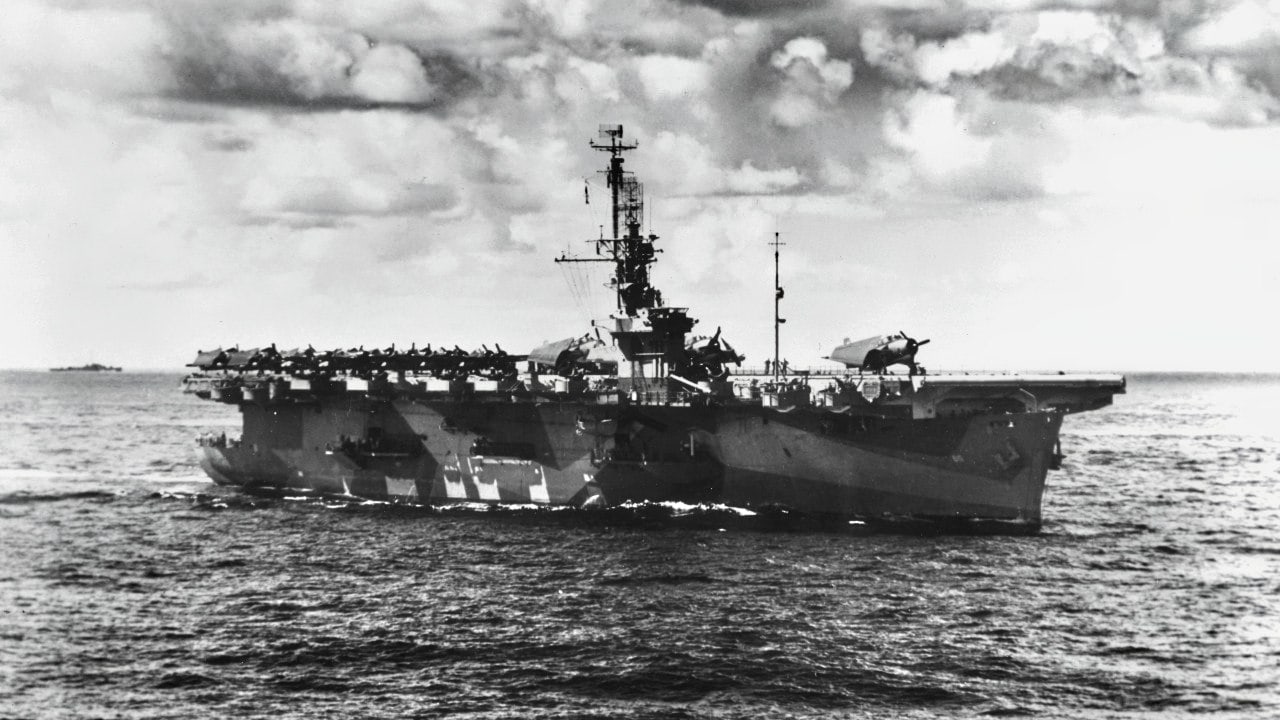Key Points: During World War II, escort carriers, nicknamed “Jeep Carriers,” were small, slow, lightly armored aircraft carriers built quickly and affordably, often on commercial hulls. They were built to help win the war as fast as possible.
-Though less capable than larger fleet carriers, carrying fewer aircraft like the F4F Wildcat, their mass production proved vital.
-The Casablanca-class was the most numerous carrier type ever built (50 ships between 1943-44).
-These carriers played crucial roles in anti-submarine warfare against U-boats and providing close air support for amphibious landings.
-Despite their wartime importance, their vulnerability led to their post-war decommissioning, with all eventually being scrapped.
The Jeep Aircraft Carrier: The Casablanca-Class
The escort carrier concept was essentially a small aircraft carrier, usually about half as long as full-sized fleet carriers, with roughly a third the amount of displacement.
Lightly armed and thinly armored, they carried far fewer aircraft than other larger carriers — but could be built very quickly, rapidly bringing more naval fighters to larger naval groups.
Several navies operated escort carriers during the Second World War, including the United States Navy, the Royal Navy, and the Imperial Japanese Navy.
Thanks to their relatively diminutive size, they were often called Jeep Carriers.
Escort carriers were not the same as light carriers; as they were often built on top of commercial ships, they had a lower top speed than light or fleet carriers but were relatively inexpensive to make.
They were at their most useful when used in support of amphibious landing operations or as anti-submarine warfare, and later in the Second World War, they hunted down German Navy U-boats along with other surface vessels.
In the Pacific, escort carriers like the Casablanca-class provided the U.S. Army and Marine Corps with close air support.
Though the Casablanca-class paled in comparison to the larger fleet carriers and couldn’t keep up even with light carriers, they were the most-produced type of aircraft carrier during the war, with fifty total built. The similar Bogue-class was the second-most, with forty-five built during the war.
Ultimately, the U.S. Navy operated about 120 escort carriers thanks to their low cost, ease of production, and the rapidity with which they could be built.
Less Capabilities, but not Necessarily Less Useful: Quantity has a Quality of its Own
Given the Casablanca-class’ shorter length compared to larger aircraft carriers, they generally launched smaller aircraft, in particular the Grumman F4F Wildcat.
Although the Wildcat’s performance against the Japanese A6M Zero was not ideal, the U.S. Navy used data gleaned from the Wildcat to design the Hellcat, a faster, higher-performance aircraft, but one that necessitated longer carriers.
One of the most remarkable aspects of the Casablanca-class was the ease of their mass-production: between 1943 and 1944, Kaiser Shipbuilding Corporation managed to build the full fifty aircraft carrier.
However, as a consequence of the class’s ease of production, they were very lightly armored compared to other surface vessels of the time and highly vulnerable to enemy fire, equipped with thin splinter plating.
Originally, about half of the fifty Casablanca-class were to be transferred to the Royal Navy for service with the British fleet. Still, the United States Navy instead decided to keep the entire Casablanca-class fleet for their service.
The subsequent Bogue-class carriers, and in particular the later builds, were eventually transferred to the Royal Navy, where they were renamed as the Ruler-class.
Post-war Service, Reactivation, Ultimate Destruction, and Scrapping
Post-war, some of the Casablancas served as aircraft transports, where their relatively low speed was not necessarily seen as a drawback.
A few Casablancas were reactivated after the war as helicopter escort carriers, essentially launchpads for the United States’ new helicopter sea fleets.
But ultimately, the entire Casablanca-class ended up at the scrap heap, sold for their metals to be recycled. A shame none were saved to become a Naval museum, like so many other warships over recent decades.
About the Author: Caleb Larson
Caleb Larson is an American multiformat journalist based in Berlin, Germany. His work covers the intersection of conflict and society, focusing on American foreign policy and European security. He has reported from Germany, Russia, and the United States. Most recently, he covered the war in Ukraine, reporting extensively on the war’s shifting battle lines from Donbas and writing on the war’s civilian and humanitarian toll. Previously, he worked as a Defense Reporter for POLITICO Europe. You can follow his latest work on X.

